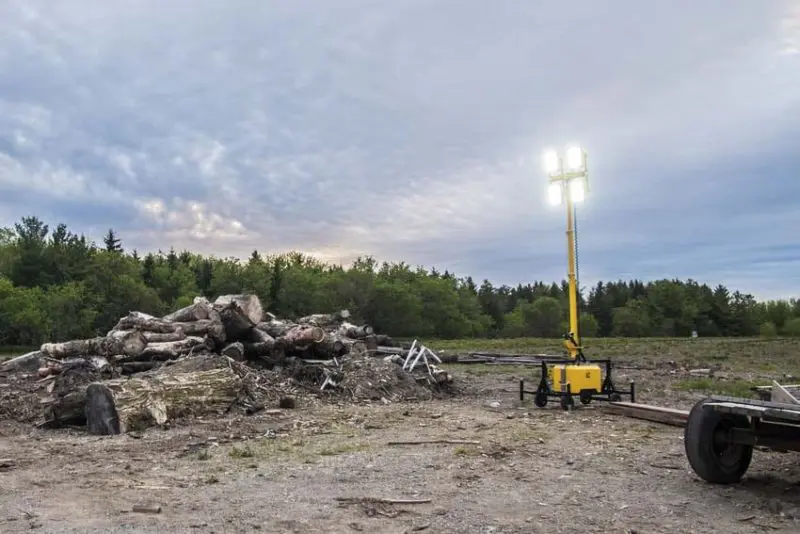We’ve traditionally used a lot of bulb-based lighting on our jobsites. While LED started making some headway in the past several years, only a few companies are bringing LED technology to larger construction area lights and even temporary lighting. These new lights cover anything from illuminating specific areas to flooding large jobsites with up to 120,000 lumens or more. Often, these larger site lights require significant amounts of power or even generators to run. Needless to say, many factors come into play when considering LED vs halogen work lights.
Running halogen or similar bulb technology can be extremely costly. First, you have to pay for fuel or electricity to power the lights. Secondly, you need to factor in maintenance and bulb replacement. Over time, this saps productivity and profitability.
It also slows you down since halogens cannot be moved or packed up until they cool.
LED vs Halogen Work Lights for Jobsites
Using LED work lights on your jobsite solves a myriad of problems. LED lights typically operate at up to 90% energy efficiency compared to halogen bulbs. That means more light and less heat. That’s great for your pocketbook and efficiency, but it also helps the environment at the same time.
Not all LED jobsite lights are the same. Many work fine for interior work or smaller jobs that don’t require larger amounts of output. For large area jobsite lighting, however, only a few companies provide solutions that can tackle rain, snow, heat, and other extreme conditions.

Another consideration is ruggedness. An LED lighting solution that installs easily might make for a great addition to your arsenal. If it breaks at the first bump or tip, however, that doesn’t gain you any productivity. LED work lights must be able to take falls and bumps or have a design that doesn’t lend itself to being knocked over.
In short, it HAS to be durable.
Temporary Lighting is Moving to LED
When you want to provide lighting for an entire work area, having the ability to daisy chain LED lights together is key. Portability also saves you money, so be sure to find a solution that can move from jobsite to jobsite. You want to be able to reconfigure your lighting without having to make multiple runs with 100-foot extension cords to the power drop.
We prefer lights that have a male “daisy-chaining” outlet for power. This lets you use standard extension cords to link up the LED lighting and fill the entire job site. This really comes into play with temporary lighting, but you also find this feature on some area lights.

Are LED Work Lights as Bright as Halogen for Jobsites?
When switching to LED work lights, people often wonder if LED work lights are bright enough for jobsites. The answer is a resounding “Yes”. In fact, companies like Lind Equipment make LED lights that put out more than 120,000 lumens and can operate for up to 45 hours on just 6-gallons of fuel (with the right generator). For another example, the 14,300-lumen brightness of a Beacon 360 blaze hanging light equals the usable light of a 400W metal halide but only consumes 100 watts of power.

Halogen vs LED Bulbs
When considering halogen vs LED bulbs, many different things come into play. For one, halogen bulbs generate way more heat than LED bulbs. While LED bulbs don’t convert 100% of the supplied energy into light, they do a much better job than halogen or filament-based products. Take a look at this general comparison grid for the two technologies:
| Halogen Bulb | LED Bulb | |
|---|---|---|
| Typical hours of life | < 3,000 | 30,000+ |
| Heat loss | High (80%+) | Low (10-20%) |
| Power consumption | High | Low |
| Cost per fixture | Medium | High |
| Durability | Low | High |
| Dimmable | Yes | Maybe |
| Color Temp | 2700K | 2700-10,000K |
What About Quality?
Lots of companies make LED lights—so how do you choose? For large purchases, we recommend sticking with companies that really know lighting. Some companies, like Lind Equipment, have been making jobsite and work area lighting for decades. Chinese knock-offs and Johnny-come-lately’s may be fine for headlamps and flashlights. Stay away from those companies when making larger purchases.
When you really want to make the switch to LED for daily jobsite lighting, established companies understand the needs of tradesmen and business owners. You want a company with a serviceable product, a good warranty, and which stands by its products.
Do LED Work Lights Cost More?
Making the switch to LED can carry significant up-front costs. The downstream savings in efficiency, maintenance-reduction, and power consumption, however, can quickly make up the difference. Whether you’re a developer or a general contractor, you can literally save hundreds of thousands of dollars between electricity and labor costs. For the tradesman, you can reduce labor time—particularly for temp lighting installation and removal.
Have You Decided Yet?
Whether you find this an easy decision or one requiring some additional math—eventually, LED lighting will be the norm. Those getting in early are laying the groundwork to save money now while others work the status quo. Increasing your competitiveness while lowering labor costs (not to mention electrical costs to your clients) is a great way to stand out in the crowd.



